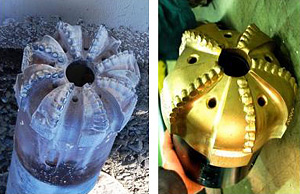Best Paper Awarded to CDEX Engineers at the 15th Formation Evaluation Symposium, 2009
April 6th 2010

RCB core bit used in the NanTroSEIZE Stage1 (left) and newly designed bit (right). Sample recovery and quality are significantly improved.
Best paper was selected from 27 papers presented at the 15th Formation Evaluation Symposium, 2009. Japan Formation Evaluation Society (JFES) is a Japan chapter of SPWLA (Society of Petrophysicists and Well Log Analysts). The testimonial will be given to the awardees at the coming JFES Symposium of this year.
<Abstract>
IODP Expeditions 315 and 316 completed their 82-day mission of scientific drilling in the Nankai Trough seismogenic zone experiment (NanTroSEIZE) Stage 1 onboard the state-of-the-art deep sea drilling vessel Chikyu. The common goal in these expeditions was core sampling using an advanced multiple wireline-type coring system. The present work presents an analysis of the geological information on the core bits used in the NanTroSEIZE expeditions in order to optimize core conditions and maintain high core recovery for future missions. Also, a new concept design of the core bit has been successfully developed and is under trial deployment in the NanTroSEIZE Stage 2 experiment with good results in improved core recovery.
<Review's comments>
It is crucial to have good core recovery and core quality in the case of scientific drilling. The deep sea riser drilling vessel Chikyu was completed in July, 2005. The wireline coring system is used by Chikyu for more efficient operations in deep undersea conditions. The authors analyzed the NanTroSEIZE Stage 1 geological formations, core recovery and core quality, and technical issues arising from the coring equipment such as the core bit in order to optimize coring and developed an improved RCB (Rotary Core Barrel) system. The RCB is used for medium to hard formations, and core recovery was rather low (average recovery rate was about 38%) during the NanTroSEIZE stage 1. The authors improved core bits based on the Stage 1 analysis. The developments include modification of the shape and number of bit blades, core shoe, number of bit nozzle, bearing, bit sub. NanTroSEIZE Stage 2 results showed better improved core recovery rate (over 80% ) and core quality than those of Stage 1. We think this paper is extremely important especially for scientific drilling community because of the significantly improved core recovery and quality. We are expecting the authors continue the development efforts to improve core recovery and core quality not only NanTroSEIZE but also other geological conditions.
